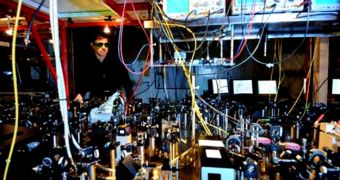In a finding that could bring the goal of constructing a quantum computer closer to reality, researchers have recently developed a new, single-atom-based system that they are calling a “quantum optical transistor.” The physics team, based at the Max Planck Institute of Quantum Optics, in Germany, and led by expert Gerhard Rempe, says that the new transistors could one day be used to create vital components for the long-sought-after quantum computers. The researchers even envision scenarios in which their innovation could play an important role as a component in a quantum data network node.
“We’re doing what people in the Bell Laboratories did in the 1950s. They were inventing the transistor, and people thought they were crazy. But 50 years later, everyone is using a laptop. […] we’re inventing the quantum transistor that may be used in computers 30 years from now,” explains team member and MPI physicist Eden Figueroa. The key to obtaining the new transistor is employing the assistance of a highly-complex light manipulation technique, that scientists call electromagnetically-induced transparency (EIT). In essence, the basic principle is the same as the one employed by gate voltage to control the current passing through a regular transistor.
The only difference is that this is not done with hardware, but with light. One beam can be used to control several properties on another one, and the researchers at Max Planck Institute of Quantum Optics are especially good with handling light. What they did was demonstrate that EIT works on a single atom, rather than on the tens of thousands present in gas. Thus far, the system was only proven to work in situations in which vast amounts of atoms were present. The MPI group managed to improve the method in a way that allows them to target a single atom, which is a feat in itself. They used a rubidium atom for the job, which was placed inside a small optical cavity, made up of two very tiny mirrors.
Then they shone a laser beam inside the cavity and tuned the light so that the atom reflected it. Afterwards, at a 90-degree inclination from the first beam, researchers fired a secondary beam, called the control laser. By fine-tuning the second laser, they were able to “create the condition of transparency,” Figueroa explains. What this means is that the optical cavity in itself was both transparent and opaque at the same time, a quantum state known as superposition. With the new work, scientists at MPI demonstrated that it is possible to store and retrieve quantum data using only light and single atoms, IEEE reports.

 14 DAY TRIAL //
14 DAY TRIAL //